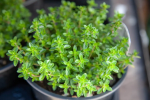For centuries, farmers worldwide have looked to the sky to guide their work with the earth. My grandfather, who was an incredibly successful small farmer, swore by planting according to the moon cycles. I grew up taking it for granted that this was the natural way to plant and harvest.
Indigenous communities and early American settlers alike timed their sowing, pruning, and harvesting to the rhythm of lunar phases. This ancient practice, often overlooked today, blends keen observation of nature with generations of agricultural wisdom.
Traditional calendars like the Old Farmer’s Almanac still reference these methods, suggesting that specific phases influence moisture levels in soil and sap movement in plants. Some believe gravitational shifts during a full moon or new moon affect seed germination, while others credit the moon’s light with triggering plant behaviors. Though modern science debates these claims, many gardeners swear by the results.
What makes this approach so enduring? It’s not just about following the stars—it’s about syncing with natural cycles to work smarter, not harder. Whether you’re growing tomatoes in Texas or corn in Kansas, understanding these patterns could transform how you nurture your crops.
Key Takeaways
- Lunar-based gardening dates back to Indigenous traditions and colonial-era practices.
- The moon’s gravitational pull may affect soil moisture and plant growth patterns.
- Specific phases are tied to ideal times for sowing seeds or pruning roots.
- Historical guides like the Old Farmer’s Almanac still reference lunar cycles.
- Modern gardeners can blend these methods with contemporary techniques.
Understanding the Legacy of Moon Planting
Long before modern calendars dictated schedules, ancient civilizations aligned their fields with celestial patterns. Indigenous tribes across the Americas timed seed sowing to the waxing moon, believing its light energized leafy greens and flowering plants. The Romans documented similar strategies—Pliny the Elder wrote about pruning during phases when sap retreated to roots.

Seeds of Tradition: Indigenous Wisdom
Native communities developed intricate lunar gardening systems over generations. The Hopi people planted corn as the new moon approached, while Pacific Northwest tribes harvested cedar bark under specific phases. These practices weren’t superstition—they reflected careful observation of how crops responded to shifting light and moisture levels.
Colonial Adoption and Almanac Guidance
Early European settlers blended their folklore with Indigenous knowledge. Benjamin Franklin’s Poor Richard’s Almanack (1732) included lunar tips that evolved into the Old Farmer’s Almanac’s planting charts. Colonial farmers discovered root vegetables thrived when planted during waning moon periods, mirroring Indigenous root crop techniques.
| Practice | Indigenous Approach | Colonial Adaptation |
|---|---|---|
| Observation Methods | Generational lunar tracking | Almanac reference guides |
| Crop Timing | Corn at moonrise | Tomatoes after frost dates |
| Knowledge Transmission | Oral storytelling | Printed calendars |
| Tools Used | Stone markers | Wooden planting sticks |
This fusion of traditions created a resilient agricultural framework. Today’s biodynamic farms still use these principles, proving that sometimes the old ways hold timeless wisdom for nurturing gardens.
How to Sync Your Garden With Lunar Phases
Gardening by the moon isn’t just folklore—it’s a strategy that harmonizes plant growth with natural cycles. By aligning tasks with lunar phases, you can work with nature rather than against it. Let’s explore how to match your schedule to these celestial patterns for healthier crops.
Waxing Moon: Ideal for Above-Ground Crops and Flowering Plants
As moonlight grows brighter after the new moon, focus on plants that produce flowers or fruit above soil. This phase energizes leafy greens like lettuce and tall growers like corn. The increasing light may boost photosynthesis, helping seedlings establish strong stems quickly.

Waning Moon: Best Practices for Root Vegetables and Bulbs
When the moon’s glow diminishes, shift attention to ground-based harvests. Carrots, potatoes, and garlic benefit from this period, as energy moves downward into roots. Transplanting during these days can reduce shock, giving plants a better start.
Track phases using free apps or the Old Farmer’s Almanac. Pair this wisdom with modern tools like soil sensors for a balanced approach. Remember: flexibility matters—adjust for frost dates or unexpected weather while staying attuned to the sky’s rhythm.
Effective Moon Planting Methods for Your Garden
Timing your garden tasks to celestial rhythms can unlock hidden growth potential. Start by mapping lunar phases to your local growing season. The Old Farmer’s Almanac suggests pairing frost dates with new moon periods for early spring seeds.
Step-by-Step Calendar Planning and Lunar Phase Tracking
Begin with a blank calendar and mark key phases: first quarter, full moon, and last quarter. Free apps like Moon Tracker simplify this process. Schedule leafy greens 2-3 days after the new moon, when sap rises in stems.
Prepare soil during waning phases—this is when gravitational pull may draw moisture deeper. Root vegetables like carrots thrive when planted under diminishing moonlight. Pair this with modern tools like moisture meters for precision.
| Tool | Traditional Use | Modern Adaptation |
|---|---|---|
| Calendar | Moon phase charts | App notifications |
| Soil Prep | Hand tilling | Electric tillers |
| Tracking | Stone markers | Smartphone reminders |
Integrating Traditional Folklore With Modern Gardening Techniques
Blend Indigenous wisdom with today’s tech. For example, use wooden planting sticks (as Pacific Northwest tribes did) alongside digital thermometers. Studies show lunar cycles influence sap flow—sync pruning to these natural rhythms.
Try this hybrid approach: Sow seeds during waxing phases per tradition, then monitor growth with LED grow lights. This honors ancestral knowledge while leveraging science-backed methods for healthier gardening results.
Scientific Perspectives and Cultural Insights
The relationship between celestial movements and agriculture has sparked both curiosity and debate. Researchers have studied whether lunar patterns truly impact plants, while cultural traditions continue to honor these rhythms. Let’s unpack what science says—and where mysteries remain.
Exploring the Gravitational Pull and Moisture Effects
Studies suggest the moon’s gravitational force subtly affects soil moisture, similar to ocean tides. A 2020 biodynamic farming trial found seed germination rates increased by 12% during new moon phases. Critics argue these effects are minimal compared to weather or irrigation practices.
| Aspect | Scientific Findings | Folklore Traditions |
|---|---|---|
| Soil Moisture | 0.5% increase during full moon | “Moon-pulled water feeds roots” (Cherokee saying) |
| Germination Timing | Mixed results across 8 studies | Corn planted “when night light returns” (Hopi) |
| Knowledge Sources | Peer-reviewed journals | Oral histories & almanacs |
Research Findings Versus Age-Old Folklore Traditions
Modern experiments often clash with generational wisdom. While NASA confirms lunar gravity impacts Earth’s crust, its effect on gardens remains debated. Biodynamic farmers report healthier root crops when using phase-based calendars, though skeptics attribute this to careful observation.
Indigenous stories describe sap rising with moonlight—a concept mirrored in recent botany studies on plant hydration cycles. Whether you trust lab data or ancestral knowledge, both paths lead to one truth: working with nature’s rhythms fosters deeper connections to the land.
Conclusion
Blending ancestral wisdom with modern gardening might just be the key to thriving crops. From Indigenous corn calendars to colonial almanacs, generations have trusted celestial cycles to guide their work with the soil. While research debates the moon’s gravitational pull, many find that syncing tasks with phases boosts germination and strengthens roots.
Here’s your invitation: Try scheduling vegetables like carrots during waning light and leafy greens as brightness increases. Track phases using free apps or that dog-eared calendar on your shed wall. Even skeptics might discover timing harvests this way adds rhythm to their garden care.
Whether you’re growing beans in Georgia or tomatoes in Ohio, this method offers a chance to slow down and observe nature’s patterns. Share your results with fellow gardeners—sometimes the oldest traditions spark the freshest ideas.




















